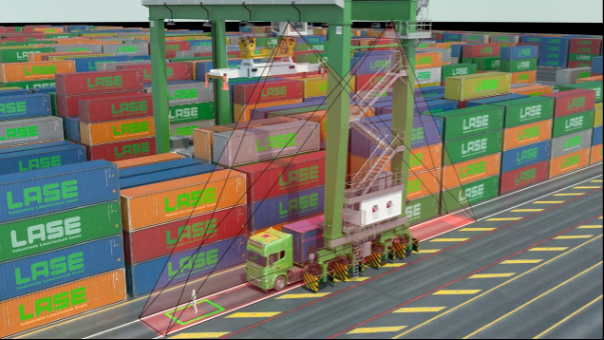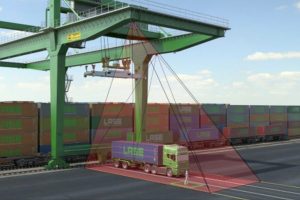Full automation for Dongwon
NewsBusan’s newest automated terminal features AGVs produced in a partnership between VDL and Hyundai Rotem.
LASE has received an important safety certification for an automation system that allows an automated yard crane to transfer a container to a road truck with the driver in the cab.

For terminals wanting to implement automated yard gantry cranes how to handle containers safely between the cranes and road trucks and manned internal vehicles is a difficult question. Crane automation technology has reached the point where container handling to and from chassis behind manned vehicles can be implemented. However, depending on the terminal layout these moves need to take place in areas where it is not safe for the driver to leave the cabin.
This includes terminals with automated RTGs and automated RMGs where trucks are handled under a cantilever. In these cases, terminal operators require a system that prevents the crane from moving if the driver has left the cab or another person enters the operating area for some reason. As with other applications where there is a need to detect people around autonomous vehicles, some terminal operators require that sensor systems for this application are certified under the ISO 13849 standard for a control system.
LASE, a leading supplier of a leading supplier of laser measuring equipment for the port industry, has now received ISO certification from TÜV SÜD Industrie Service GmbH for its LaseASTO (Area Surveillance Truck Operation) to EN ISO 13849 to Performance Level D cat. 3. In an interview with WorldCargo News Lase Managing Director Lars Ambrosy explained that the certification means TÜV has verified both that LaseASTO can reliably detect the presence of a person outside a vehicle in the truck operation area and that a single fault in a safety-relevant part of the controller does not result in a loss of safety function.

LaseASTO uses two 3-Dimensional multilayer laser scanners mounted on the crane at a height of 20m focused on the truck handling area. The scanners can detect an object as small as 300mm square. When a truck enters the handling area it is scanned and defined as an “allowed object”. LaseASTO can detect any other object in the area, including a driver that has left the cab of the road truck or a person that enters the area from outside. The system then sends a signal to the crane PLC, drives or brakes that can be used to stop any or all crane motions.
LaseASTO is a two-channel system according cat.3 design criteria. Both the collision detection, and the detection of errors in the system, is evaluated in two separate computers that are cross referenced.
Ambrosy said that the key advantage of LaseASTO is that it enables road truck to be handled fully automatically under ARTG and ARMG cranes by removing the need for the remote operator to verify that that no people are in the exchange zone. A remote operator might still be needed for an exception that prevents the move from being completed for another reason, but the overall number of moves requiring remote operator intervention is reduced dramatically.
Ambrosy added that a certified system to achieve this is something terminal operators have been asking for for some time. LASE had been working on certification for around two years and was issued a certificate by TÜV SÜD Industrie Service GmbH in late December 2023.
The certification gives terminal operators the assurance that the measurement system can reliably detect and provide an output signal indicating there is an object in the truck handling area that is not the truck itself. LaseASTO needs to be installed according to its specifications and documentation, but certification does not require any third-party onsite verification. The system is now undergoing testing on ARTGs that will be installed at a terminal in Europe.
This is an important development for container terminal automation. Increasingly, terminals are looking to push beyond closed-zone automation, where the only way automated machines can operate is behind a safety fence where no manned machines can enter. Container terminals, like other industrial applications, are looking for ways for automated machines and manned equipment to operate safely alongside one another.
By subscribing you will have: